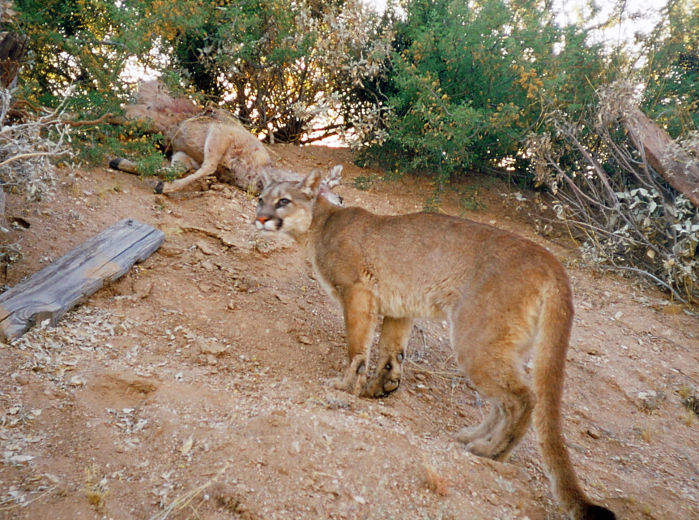

Drought – Wildlife will come into urban fringe areas to search for food and water.

Other factors that may contribute to mountain lions presence around humans include:
Mountain lions might use “cave-like” areas beneath sheds, unused buildings, and storm drains, or elevated wooden patios, for shelter. Water for drinking can include a swimming pool, fountain, pond, or pet’s water bowl. Food sources found near people’s homes includes deer, javelina, rabbits, unsecured domestic animals, or livestock. Mountain lions most often pass through human-occupied space, but may stay longer if they have access to food, water, or shelter. Although uncommon, mountain lion attacks on humans occasionally occur. Conflicts can occur when a mountain lion becomes too accustomed to the presence of people, often near where we live or recreate, and begin preying on livestock or other domestic animals. Urban sprawl often results in shrinking habitat and increases the number of conflicts between humans and wildlife, such as mountain lions.  Diet is primarily deer, but also includes javelina, bighorn sheep, elk, small mammals and occasional depredation on livestock and pets.
Diet is primarily deer, but also includes javelina, bighorn sheep, elk, small mammals and occasional depredation on livestock and pets.  Territory sizes range from 10 to 150 square miles males range more widely than females. Rarely make vocal noises, unless during breeding season or when threatened. Can jump 20 feet vertically and 40 feet horizontally in a single leap. Live up to 13 years in wild with average of less than 6 years. Kittens stay with mother for approximately 18 months. Average litter of three kittens, which are yellowish-brown with black spots. 25-32 inches tall at the shoulder (similar to a German shepherd dog). 70-150 pounds (males usually larger than females). Long tail that is about 2/3 of body length, white underneath with a dark brown or black tip. Tan or reddish brown to dusky or slate gray coat young have numerous black spots that mostly disappear with age. Understanding Mountain Lion Management in Arizona - The facts about Arizona’s robust and expanding mountain lion populationĪrizona Mountain Lions (video) Description and Habits Signs of mountain lion presence include large tracks (3-5 inches wide) without claw marks large segmented, cylindrical droppings food caches where a kill has been partially eaten and then covered with leaves, brush or dirt and scrapes in soft dirt or leaf litter. Mountain lions are solitary animals with the exception of females with kittens or breeding pairs. The current population estimate can be found on the Learn About Arizona’s Big Cats web page. Because mountain lions are shy and elusive, people do not often see them. Mountain lions can be found throughout Arizona and are most common in rocky or mountainous terrain. Visit our ‘Learn About Mountain Lions in Arizona’ page for information on mountain lion facts and management.
Territory sizes range from 10 to 150 square miles males range more widely than females. Rarely make vocal noises, unless during breeding season or when threatened. Can jump 20 feet vertically and 40 feet horizontally in a single leap. Live up to 13 years in wild with average of less than 6 years. Kittens stay with mother for approximately 18 months. Average litter of three kittens, which are yellowish-brown with black spots. 25-32 inches tall at the shoulder (similar to a German shepherd dog). 70-150 pounds (males usually larger than females). Long tail that is about 2/3 of body length, white underneath with a dark brown or black tip. Tan or reddish brown to dusky or slate gray coat young have numerous black spots that mostly disappear with age. Understanding Mountain Lion Management in Arizona - The facts about Arizona’s robust and expanding mountain lion populationĪrizona Mountain Lions (video) Description and Habits Signs of mountain lion presence include large tracks (3-5 inches wide) without claw marks large segmented, cylindrical droppings food caches where a kill has been partially eaten and then covered with leaves, brush or dirt and scrapes in soft dirt or leaf litter. Mountain lions are solitary animals with the exception of females with kittens or breeding pairs. The current population estimate can be found on the Learn About Arizona’s Big Cats web page. Because mountain lions are shy and elusive, people do not often see them. Mountain lions can be found throughout Arizona and are most common in rocky or mountainous terrain. Visit our ‘Learn About Mountain Lions in Arizona’ page for information on mountain lion facts and management.












